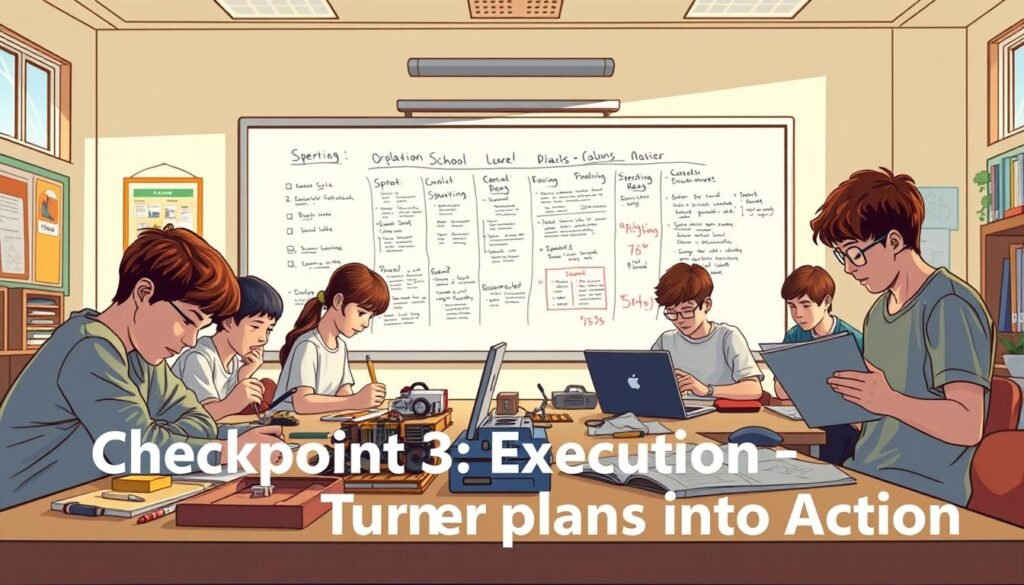Ever wondered how some individuals manage to juggle coursework, extracurriculars, and still deliver outstanding results? The secret lies in structured planning and effective management. Whether it’s developing a solar-powered wheelchair or launching a mental health campaign, a clear system can make all the difference.
This article introduces a 4-checkpoint system designed to simplify complex tasks. Tools like Trello and Asana, along with frameworks like PMBOK, will be explored to help you stay organized. These skills aren’t just for school—they’re essential for professional success after graduation.
Key Takeaways
- Structured planning helps balance multiple responsibilities.
- The 4-checkpoint system simplifies task execution.
- Tools like Trello and Asana enhance organization.
- Real-world examples include solar-powered wheelchairs and mental health campaigns.
- These skills prepare you for professional success.
Why Project Planning for Students is Essential
Managing multiple tasks effectively can be a game-changer for academic and personal growth. Many individuals struggle with balancing time, resources, and activities, leading to stress and missed deadlines. According to research, 72% of people report time management as their top challenge.
Poor planning often results in incomplete objectives, team conflicts, and wasted effort. For example, middle schoolers improved their task analysis by using butcher paper timelines. This simple technique helped them visualize their work and stay on track.
Engineering students successfully managed a solar-powered wheelchair initiative by applying project management principles. Their structured approach ensured they met deadlines and utilized resources efficiently. This case study highlights the importance of planning in achieving complex goals.
Developing management skills through planning prepares individuals for future challenges. These transferable skills are essential for career readiness and professional success. Whether it’s academic tasks or real-world activities, a structured approach makes all the difference.
Checkpoint 1: Ideation – Brainstorming Your Project Idea
Starting with a strong idea is the cornerstone of any successful endeavor. This phase is all about creativity and clarity. Begin by exploring different concepts and refining them into actionable plans.
How to Generate Creative Ideas
Mind mapping is a powerful tool to organize thoughts. Use platforms like Miro or even physical sticky notes to visualize connections. Another effective method is the 5 Whys technique, which helps identify the root cause of a problem and sparks innovative solutions.
For example, when studying Earth Science, aligning your goals with rubrics can help focus your brainstorming. Conducting “Day in the Life” exercises also ensures your idea resonates with the intended audience.
Aligning Your Idea with Objectives
Once you have a concept, ensure it aligns with your goals. The LAUNCH Cycle’s PARTS framework is a great way to structure this. It breaks down the process into Product Idea, Audience, Roles, Tasks, and Solution.
Using a worksheet template for the 5 Ws (Who, What, Where, When, Why, How) can further clarify your requirements. Additionally, PMBOK’s stakeholder analysis templates help identify key players and their roles in the team.
By combining these techniques, you can turn a simple idea into a well-defined plan. This structured approach ensures your tasks are clear and your objectives are achievable.
Checkpoint 2: Planning – Setting the Foundation for Success
Building a solid foundation is the key to achieving any goal efficiently. This phase involves defining clear objectives, mapping out timelines, and assigning roles. A well-structured plan ensures everyone knows their tasks and deadlines.
Defining Objectives and Timelines
Start by creating SMART goals—Specific, Measurable, Achievable, Relevant, and Time-bound. For example, a documentary project spreadsheet can help track milestones. Visual tools like Gantt charts are excellent for mapping out a schedule and identifying critical steps.
Special education classes often use sticky-note butcher paper calendars to visualize timelines. This simple method keeps everyone on the same page and ensures deadlines are met.
Establishing Roles and Responsibilities
Assigning roles is crucial for smooth execution. The RACI matrix—Responsible, Accountable, Consulted, and Informed—helps clarify who does what. For instance, engineering students divided R&D roles in their wheelchair initiative, ensuring efficient use of team members.
Digital tools like Trello and Asana streamline role allocation, while analog methods like notecard Kanban boards offer flexibility. A downloadable 4Ts worksheet (Tasks, Time, Team, Tools) can further simplify this process.
By combining these techniques, you can create a clear and actionable plan. This structured approach ensures every task is accounted for and every team member knows their responsibilities.
Checkpoint 3: Execution – Turning Plans into Action
Execution is where strategy meets reality, and results begin to take shape. This phase focuses on implementing the plan while maintaining clear communication and tracking progress. It’s the bridge between ideas and tangible outcomes.
Coordinating with Team Members
Effective project management relies on seamless collaboration. Tools like shared Google Docs are used by 63% of groups for real-time updates. Daily standup meetings, like those in a mental health campaign, ensure everyone is aligned on tasks and goals.
Conflict resolution is also key. The 5 Whys technique, used in software development, helps identify root causes of issues. This approach fosters better understanding and smoother teamwork.
Tracking Progress and Making Adjustments
Visual tools like Trello’s progress bars and Asana’s timeline views provide clarity on progress. Automated status reports, created with spreadsheet conditional formatting, save time and keep everyone informed.
When challenges arise, like tech failures or absences, pivoting strategies are essential. For example, a team might reassign tasks or adjust timelines to stay on track. Flexibility ensures that action continues despite setbacks.
By combining these methods, teams can execute plans effectively and achieve their objectives. This structured approach ensures that every effort contributes to the final result.
Checkpoint 4: Monitoring and Control – Staying on Track
Staying on track requires constant vigilance and adaptability. This phase ensures that progress aligns with goals while addressing potential risks. Effective monitoring prevents missed deadlines and keeps plans on course.
Assessing Risks and Adjusting Plans
Identifying risks early is crucial. Tools like risk matrices help evaluate the likelihood and impact of potential issues. For example, a classroom fire drill contingency plan ensures preparedness for unexpected events.
When deadlines are at risk, adjustments are necessary. A documentary team might revise timelines to accommodate unforeseen delays. This flexibility ensures that progress continues despite challenges.
Using Dashboards for Real-Time Updates
Real-time dashboards provide instant visibility into progress. Tools like AceProject, Trello, and Google Sheets offer customizable views. For instance, coding teams use AceProject to track tasks and identify bottlenecks.
Post-mortem analysis, guided by PMBOK’s lessons learned templates, helps refine future plans. This reflective practice ensures continuous improvement and better project management outcomes.
Tools and Resources for Effective Project Planning
Effective project management relies on the right tools and frameworks to streamline tasks and achieve goals. Whether you’re coordinating a team or managing deadlines, having the right resources can make all the difference.
Popular Tools Like Trello and Asana
Trello and Asana are two of the most widely used tools for organizing tasks. Trello’s Kanban boards are perfect for visualizing workflows, while Asana’s Gantt charts help track timelines. Both platforms offer free versions, making them accessible for beginners.
For example, Trello’s Butler power-ups automate repetitive tasks, saving time and effort. Asana’s timeline view ensures everyone stays on track with deadlines. These features are particularly useful for project managers juggling multiple responsibilities.
Frameworks Like PMBOK for Learning
The PMBOK framework provides a structured approach to project management. It includes over 12 templates, such as risk registers and project charters, which can be adapted for academic use. These resources help clarify roles, objectives, and timelines.
For instance, PMBOK’s stakeholder analysis template ensures all team members are aligned. This framework is ideal for those new to project management and looking to build foundational skills.
To get started, explore free student licenses like Asana for Education and Notion Edu. Additionally, platforms like Coursera and Harvard’s project planning guide offer valuable learning opportunities. With the right tools and frameworks, you can master the process and achieve success.
Conclusion: Mastering Project Planning for Future Success
Mastering structured approaches can unlock future opportunities. The 4-checkpoint system, from ideation to monitoring, ensures efficient task execution. For example, a mental health campaign successfully applied this method, achieving measurable results.
These skills are transferable to capstone tasks and graduate studies. Employers value project management expertise, with 89% prioritizing it in hires. Engineering individuals secured internships by showcasing their portfolios.
Take actionable steps to build your career. Join the PMI Student Chapter or create an Asana portfolio. Many university courses offer certifications to enhance your learning.
Ready to get started? Download our checklist of tools and frameworks to streamline your journey toward success.
FAQ
Why is project planning important for students?
It helps students organize tasks, manage time, and achieve goals efficiently. It also builds essential skills like teamwork and problem-solving.
How can students generate creative ideas for their projects?
Brainstorming sessions, researching trends, and discussing with peers can spark innovative concepts. Aligning ideas with objectives ensures relevance.
What are the key steps in setting a project foundation?
Define clear objectives, set realistic timelines, and assign roles and responsibilities to team members for smooth execution.
How can students effectively coordinate with their team?
Regular communication, using tools like Trello, and tracking progress ensure everyone stays aligned and tasks are completed on time.
What should students do if they face challenges during execution?
Assess risks, adjust plans, and use dashboards for real-time updates to stay on track and address issues promptly.
What tools can students use for project management?
Popular tools like Trello and Asana, along with frameworks like PMBOK, can help students manage tasks and timelines effectively.
How can students ensure their project stays on track?
Monitor progress, communicate regularly, and make adjustments as needed to meet deadlines and achieve goals.









